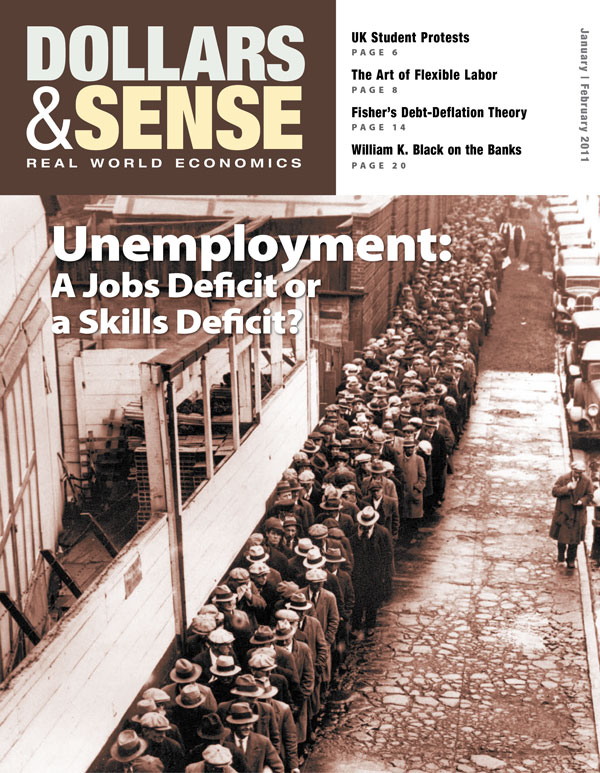
(1) Comparisons with the Great Depression: The cover story for our Jan/Feb Issue, which is just going to the printers (but will be available in full color to e-subscribers by Wednesday, possibly earlier), is about unemployment--in particular the claim, rampant in the media these days, that today's unemployment is "structural," and has to do with a mismatch between the skills workers have and those required by the jobs that are being created. Authors John Millerand Jeannette Wicks-Lim demolish this notion nicely and argue that it's not a skills deficit, but a jobs deficit, and one created by insufficient demand and employers who are unwilling to hire when they don't see demand for what they're producing.
Anyhow, to illustrate the article, we've had to use an image of a bread line for the unemployed from the 1930s, which prompted us to ask, in our editorial note, whether comparisons between the current and ongoing economic crisis and the Great Depression are legitimate. A great post on Washington's Blog--well worth reading--helped make the case. That post is here, and here's the editorial note:
At the 1992 Republican National Convention, George H.W. Bush promised that the Republican Party would keep trying to make the American family “more like the Waltons and less like the Simpsons.” In the closing credits of The Simpsons just two days later, Bart looked into the camera and quipped, “Hey, we’re like the Waltons. We’re praying for the end of the depression, too.”
Bart had a point. That recession had been over for more than a year by the time of the convention, yet unemployment had peaked (at 4.7%) only two months earlier. And if the recession that helped sweep Bill Clinton into office felt like a depression to Bart Simpson, then the Great Recession, which helped sweep Barack Obama into office, but was also responsible for the Democrats’ “shellacking” in the midterm elections, surely does as well, even 18 months after its official end.
Is it over the top to compare today’s economic scene with the Great Depression? A recent post on Washington’s Blog, an anonymous weblog that has had good coverage of the economic crisis, argues that key indicators that directly affect ordinary people (as opposed to, say, GDP, the Dow, or profit-levels) rival those of the ’30s. Some (e.g. the decline in housing prices) are almost as bad, while several others (e.g. loan loss rates, states’ and cities’ finances, and inequality) are definitely worse. And while unemployment reached nearly 25% in the Great Depression, the Bureau of Labor Statistics’ expanded U-6 measure (which includes underemployed and discouraged workers) is almost that high in some parts of the country and among some segments of the population. What’s more, over six million people have been unemployed for 27 weeks or longer.
Were it not for the tattered remnants of the New Deal and the Great Society, the depth of today’s economic collapse would be more apparent. Consider the breadline for unemployed men shown in this issue’s cover photo. As the author of Washington’s Blog points out, part of why we don’t see soup kitchens and bread lines today is that one in seven people—43 million—receive food stamps. And to think that the forces of reaction are busy trying to further erode what little is left of the social safety net—including food stamps and unemployment compensation.
George H.W. Bush may have been nostalgic for the Waltons, but his policies—and those of Reagan before him, and of every president since—have undoubtedly conspired to recreate the conditions of the Great Depression.
(2) Scary Unemployment Data: I stumbled on this useful site when I was working on the editorial note (the Washington's Blog post might have linked to it). Blytic.com is apparently a Boston-based research outfit, and they put together this "Scary Unemployment" page, billed as "Some of the most frightening unemployment data!" (the exclamation point is in the original). Indeed, the graphs are pretty frightening--a real horror show.
(3) Another Depressing Item: From Brave New World to 1984: While I'm making depressing comparisons between now and the Depression, it is worth mentioning a recent piece by Chris Hedges, 2011: Brave New Utopia. Hedges, whose work I've only recently really noticed (and I like what I see), asks whether Huxley or Orwell is the right dystopian model for our current "descent towards corporate totalitarianism." His depressing answer--they were both right:
The two greatest visions of a future dystopia were George Orwell’s “1984” and Aldous Huxley’s “Brave New World.” The debate, between those who watched our descent towards corporate totalitarianism, was who was right. Would we be, as Orwell wrote, dominated by a repressive surveillance and security state that used crude and violent forms of control? Or would we be, as Huxley envisioned, entranced by entertainment and spectacle, captivated by technology and seduced by profligate consumption to embrace our own oppression? It turns out Orwell and Huxley were both right. Huxley saw the first stage of our enslavement. Orwell saw the second.
Read the full article.
I hope to have something more optimistic to say as 2011 moves along! Maybe WikiLeaks' dirt on Bank of America will perk us all up.
Happy New Year! I will do the web update with at least one article from the Jan/Feb issue tomorrow. But you should subscribe, or please donate.
--Chris Sturr
